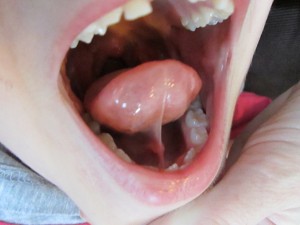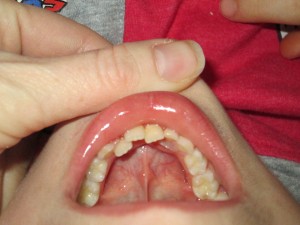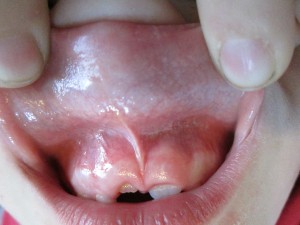Anyone who knows me personally, or even through just reading about me here on my website knows I have only recently really delved into the whole tongue tie world. With my first I don’t remember it being mentioned at all. And we had a lot of issues and tried a lot of things. When my second was born I was told “maybe it’s a tongue tie, go see an ENT.” The ENT said “there might be a small tie, but if I clip it, it will scar right back where it is, so there’s no point, just deal with it.” And later we would joke that she belonged in KISS the way her tongue stuck out (FYI – you can still be tongue tied and be able to stick your tongue way out. I didn’t know that then. Also, that’s a terrible answer from an ENT, on so many levels. If you get that, or a variation thereof, leave and seek out a preferred provider.) It was the birth of my youngest that sent me down this rabbit hole of tongue tie and ALL the implications of it.
This ASHA article came across my radar when it was first published in September of 2015, and it was a sudden epiphany. OH. MY. GOSH. My oldest is tongue tied! THAT’S why we had SO many issues with breastfeeding. It explains EVERYTHING! Now, he didn’t have all the symptoms of this particular case, but enough of them to warrant a serious look at the issue. I had already scheduled an intensive training with Jessica Altemara, IBCLC to learn more about tongue tie myself and to get others in Columbia educated on the issue. While she was there she took one look in my sons mouth and said, um, yes. Those pockets? Not supposed to be there.

Obviously, the ASHA article gives plenty of reason for releasing that child’s restrictive frenulum, but I often get asked what are the reasons for releasing my son’s. And why didn’t I have his done when he was a baby? He had a couple symptoms I’ll spare him the future embarrassment of sharing (the internet is forever, right?), but his primary, publicly appropriate, symptoms were dental and orthodontic. Problem number one: He couldn’t sweep his back teeth, so he was actually chewing with his front teeth and premolars because he was afraid of getting food stuck back there and getting cavities. A valid concern, and an interesting, though somewhat concerning solution. And problem number two: The tie was attached at the front of the floor of his mouth, close to his gums, so it was actually pulling his adult teeth back and causing them to erupt BEHIND his baby teeth rather than pushing them up and out of the way. We have dubbed these his shark teeth. ALL of his bottom teeth have come in as shark teeth. Fortunately he’s “dentally delayed” and at 9 has only had 4 of those teeth come in. We are hoping that the release prevents this from happening with any future teeth. And that his jaw will now be able to grow appropriately to give space for the larger adult teeth and lessen (or remove? A mom can dream…) the need for orthodontic work later in life.

As for why we didn’t do a release when he was a baby? Simple. We didn’t know. He just turned 9. The majority of people who have been working with tongue tie “forever” have been doing so for about 10 years. He was born in 2007 and one of the most important studies relating to breastfeeding and tongue tie was published in 2008. Ironically it was accepted the day after he was born, but not published for 18 months. After he had weaned. The information just wasn’t as widely spread. Even now, we run into so many people who have never heard of it, especially a posterior tongue tie.
Interestingly, he did not have a lip tie, even though typically the two come together and it’s pretty rare to have one without the other.

Armed with knowledge that he has a tongue tie, and that having it released could improve his health in various ways we made a plan to get it done. And since this is usually a procedure done on babies who can’t verbalize much to tell us what is happening I’ll report back frequently in hopes it may help your baby, or your big kid.

Nice post. My youngest has a tongue tie and I never thought to get it released since we have made it this far with no identifiable problems, but looking at her teeth makes me wonder if the crowding could be helped by a release.